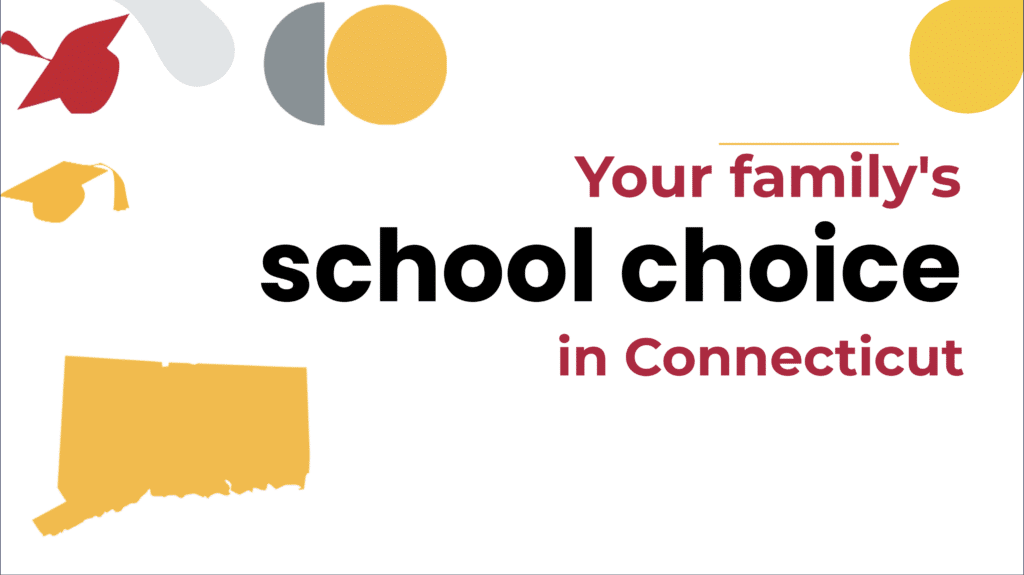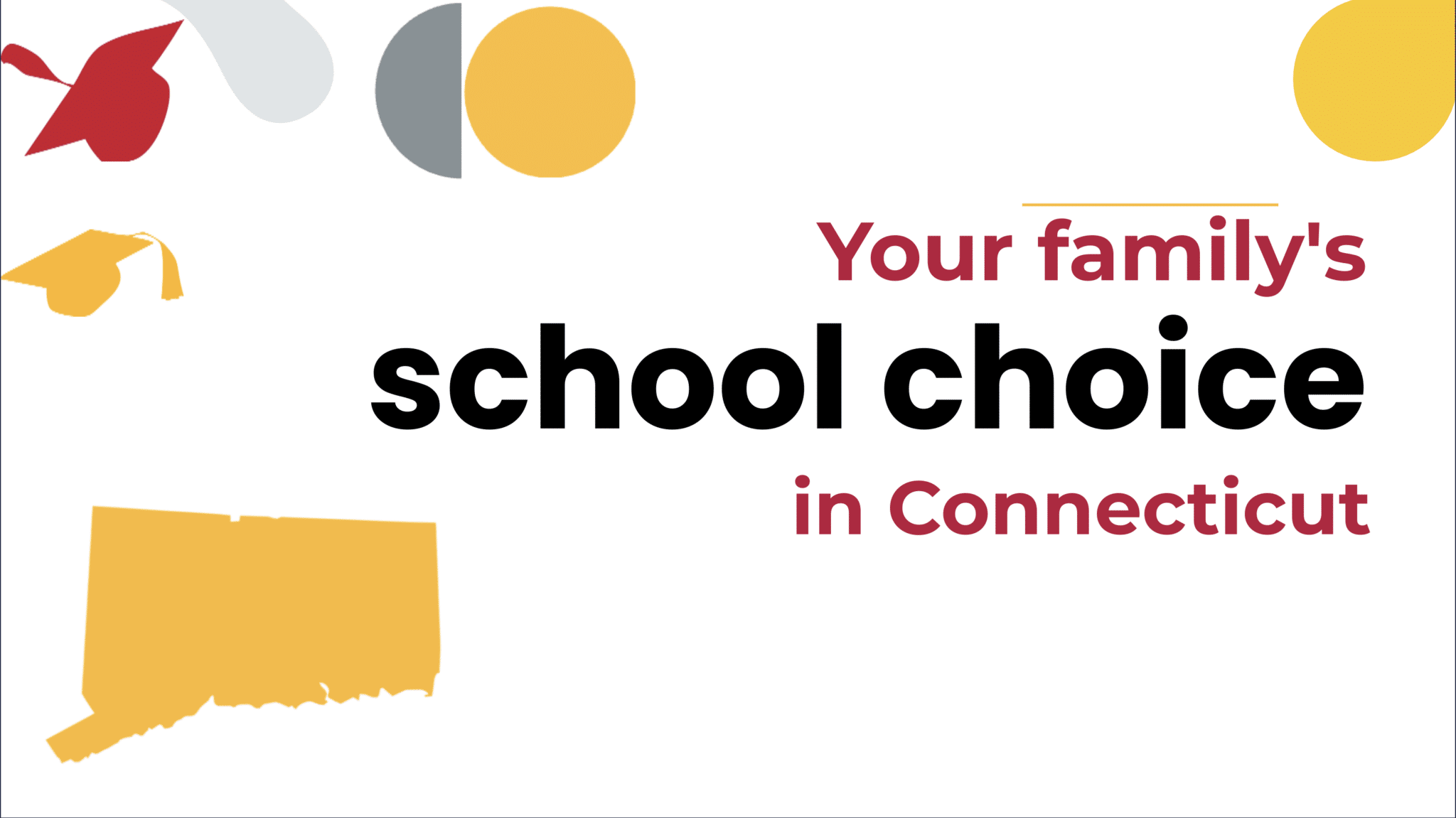Choosing a school? You’ve got options.
Deciding where to send your child to school is one of the biggest decisions you face as a parent. Navigating your choices for K-12 education starts with knowing school choice options are available to you in Connecticut. There may be more options than you realize! Once you’re equipped with knowing your options, you can make the best choice for your family.
Connecticut families can choose from traditional public schools, public charter schools, public magnet schools, private schools, online learning, homeschooling, and microschooling and mix-and-match learning.
Looking for special education options? You can learn what special education services are available in Connecticut at the Ultimate Guide to Special Education.

- Traditional Public Schools
- Public Charter Schools
- Public Magnet Schools
- Private Schools
- Online Schools
- Homeschool
- Microschooling
Connecticut Traditional Public Schools
Most children in Connecticut (77.3%) attend traditional public schools. Traditional public schools are free to attend, open to all students, operated by school districts, and funded by federal, state, and local government. Did you know that Connecticut spends an average of $22,769 per public school student each year? You can search your school’s spending and that of nearby schools at Project Nickel.
Connecticut has restricted open enrollment for public school. What this means is that parents in some Connecticut cities may be able to choose traditional public schools outside of their districts. This applies in Hartford, Bridgeport, New Haven, and New London, and may apply in other cities. Transfers within districts are sometimes an option as well. As a real-world example, you may wish to view the transfer application for switching schools within Norwalk Public Schools. Local boards of education decide whether to provide transportation for students participating in open enrollment.
If you live in an area of Connecticut with open enrollment, take advantage of this option by visiting multiple public schools near you and discovering which is the best fit for your family. Traditional public schools aren’t all the same: They may differ in learning methods and one may just “feel different” than another to you.
If you would like to participate in open enrollment, contact your local district for more information. Connecticut prohibits districts from charging tuition for transfer students, so open enrollment is always a free option for families.
The entry age for kindergarten in Connecticut is changing. From the 2024-2025 school year onwards, children need to be five years old by September 1st, 2024, to start kindergarten.
Find out more about public schools in your state at the Connecticut State Department of Education and learn more about Connecticut open enrollment in “Public Schools Without Boundaries: A 50-State Ranking of K-12 Open Enrollment.”.
Connecticut Charter Schools
Charter schools are another free school option for Connecticut families. Connecticut passed a charter school law in 1996 and now has more than 20 public charter schools that serve over 2% of the K-12 student population. While no new charter school has opened in the state since 2015, an all-boys charter school is in the pipeline to open in New Haven.
Like traditional public schools, charter schools are public, free, and usually have no requirements for entry. What distinguishes charter schools is that they have extra freedom to innovate with curriculum and learning methods and are accountable to authorizing entities (like school districts or colleges) for results.
Each school has a charter which explains the school’s purpose and what specific community need it serves. That could be providing a Spanish immersion program or offering a rigorous, literacy-based curriculum. If there are more families seeking admittance to a charter school than there are seats, a good old-fashioned lottery system is usually used to determine admittance.
New for 2023: While Newark Enrolls has been a common application platform for traditional public schools and charter schools in the past, seven charter networks have now switched to a new enrollment platform called the Newark Common App. Families interested in North Star Academy, KIPP, Great Oaks Legacy, Marion P. Thomas, Achieve Community, People’s Preparatory, and Philip’s Academy should use the Newark Common App moving forward.
Free transportation is available to all students who attend charter schools in Connecticut and live within the district where their charter school is located. Students with special needs who have an Individualized Education Program (IEP) and students facing homelessness are eligible to receive transportation assistance.
To learn more about charter options in your state, check out the Northeast Charter Schools Network.
Connecticut Magnet Schools
Depending on where you live in Connecticut, you may also be able to choose a magnet school. These schools are free public schools that allow kids to focus on specific themes or tracks, like STEM or the performing arts. For example, Breakthrough Magnet School in Hartford has a unique character education curriculum; the school has been recognized two years in a row for exemplary performance by Magnet Schools of America. Meanwhile, the Bristol Arts and Innovation Magnet School has two fully functional theaters and offers pathways in theater and creative construction. A magnet school might be a good option if your child learns best by focusing on a subject they are passionate about.
Connecticut has more than 90 magnet schools that serve 8.3% of the K-12 student population, more than half of which are interdistrict. An estimated 33,000 Connecticut students attend magnet schools. To find your local magnet school, use the complete list of Greater Hartford area magnet schools (there are more than 40!).You may also find frequently asked questions about Connecticut magnet schools and a family guide to school choice in the greater Hartford Region helpful. You may also find New Twists in Connecticut’s Magnet School Admissions to be helpful.
Connecticut Private Schools
While magnet schools are a choice many parents haven’t heard of, most families are familiar with private schools. Connecticut’s private schools come in all shapes and forms, from religious schools to schools designed for children with special needs. One innovative private school in Connecticut, Education without Walls, is located on a farm in New Milford and offers courses in computer science, cooking, and improvisation, as well as core subjects.
There are more than 420 private schools across the state of Connecticut that serve 10% of the K-12 student population. The average tuition for private schools in the state is $22,648 for elementary schools and $40,783 for high schools. In Connecticut, there are no state-run scholarships to help families afford private school tuition, but privately-funded scholarships may be available. Additionally, the federal government allows parents to save for K-12 private school tuition using tax-preferred 529 savings accounts.
Learn more at CEO Foundation of Connecticut, the Connecticut Catholic Conference, and Private School Review: Connecticut.
Connecticut Online Learning
While most states have free online school programs, Connecticut only has paid options available at present, such as George Washington University Online High School, The Keystone School, Excel High School, and K12 Private Academy. While the schools are available to families in Connecticut for a fee, they are not specific to the state.
Many Connecticut districts do offer online options for credit recovery.
To read more about online learning in Connecticut, check out the Digital Learning Collaborative’s state profile.
Connecticut Homeschooling
Also, Connecticut families can choose homeschooling, the process of parents educating students at home. You can homeschool in all 50 states and homeschooling is an increasingly popular choice. As both technology and school choices have spread in Connecticut, there are more support and resources for homeschooling than ever.
In Connecticut, 2.5% of all K-12 students are homeschooled. It is recommended that families file an optional notice of intent to homeschool within 10 days of beginning homeschooling. Notice may be requested by districts annually. It is also recommended that you formally withdraw from your current school so that your student is not marked truant.
If you choose to homeschool, you are required to teach specific subjects (like reading, U.S. history, and geography) but specific standardized tests are not required. In general, children who are homeschooled may face roadblocks if they want to participate in public school sports in Connecticut. However, you can look for other sports leagues near you.
To learn more about homeschooling in Connecticut, check out the Home School Legal Defense Association – Connecticut for a great how-to. You may also wish to check out the Connecticut State Department of Education’s homeschooling page, the CT Homeschool Network, or the CT Education Association of Christian Homeschoolers.
Connecticut Microschools and Mix-and-Match Learning
Increasingly, Connecticut families are blending school options to come up with creative new ways to personalize education. Microschools are one of these ways. A microschool refers to students gathering together in a small group – with adult supervision – to learn, explore, and socialize. Microschools can take a variety of shapes and legal forms, from homeschoolers coming together at an enrichment center to a private school committed to small classrooms. What microschools share in common is a commitment to small-group learning, close-knit relationships, and emphasizing children as individual learners.
Here are a few real examples of microschools and related resources in your state:
One example of homeschoolers gathering in a pod-like community is LearnerSpace in Bethel.
From Seeds to Sprouts is a Private Education Association establishing a one-room schoolhouse with collaborative homeschooling. From Seeds to Sprouts is located in Shelton.
The Connecticut Invention Convention is an education non-profit supporting K-12 innovation and entrepreneurship.
A Wildflower Montessori microschool, Sankofa Learning Center, is coming soon to Connecticut.
Remember, microschooling is more a mentality than a specific legal distinction in most cases. Often, a family participates in a microschool while legally homeschooling, or being enrolled in a private or online school.
Search for Schools Near Me
Microschooling and Mix-and-Match Learning
How can it empower parents and help kids achieve their dreams?
7 Step Guide
Tips to help you find a school where your daughter or son will learn, succeed, and be happy.
Education Resources for
Connecticut Parents
For additional information about school choices in
Connecticut, visit these resources:
Every state is different when it comes to school choice options.
Sign up below to get a detailed comparison:
"*" indicates required fields

